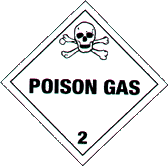Sulfur dioxide
- Sulfurous anhydride
- Sulfur oxide

Sulfur dioxide | |
| |
| Formula | SO2 |
| Structure |  |
| Description | A colorless gas with a choking or suffocating odor. |
| Uses | Preserving fruits, disinfectant in breweries & food factories. |
| Registry Numbers and Inventories. | |
| CAS | 7446-09-5 |
| EC (EINECS/ELINCS) | 231-195-2 |
| EC Index Number | 016-011-00-9 |
| EC Class | Toxic; Corrosive |
| RTECS | WS4550000 |
| RTECS class | Agricultural Chemical and Pesticide; Tumorigen; Mutagen; Reproductive Effector; Human Data; Primary Irritant |
| UN (DOT) | 1079 |
| Merck | 12,9144 |
| Beilstein/Gmelin | 1443 (G) |
| EPA OPP | 77601 |
| Swiss Giftliste 1 | G-2871 |
| Canada DSL/NDSL | DSL |
| US TSCA | Listed |
| Austrailia AICS | Listed |
| New Zealand | Listed |
| Japan ENCS (MITI) | Listed |
| Korea ECL | Listed |
| Properties. | |
| Formula | O2(32)S |
| Formula mass | 64.05 |
| Melting point, °C | -75.7 |
| Boiling point, °C | -10.3 |
| Sublimation point, °C | -165.2 |
| Vapor pressure, mmHg | 43.7 (-60 C) |
| Vapor density (air=1) | 2.2 |
| Critical temperature | 157 |
| Critical pressure | 77.7 |
| Density | 1.434 g/cm3 (20 C) |
| Solubility in water | 8.5 g/100 mL (20 C) |
| Viscosity | 0.0124 cp (18C) |
| Surface tension | 28.59 g/s2 (10 C) |
| Refractive index | 1.3047 (20 C) |
| Dipole moment | 1.634 D |
| Dielectric constant | 22.93 (-61 C) |
| Thermal expansion | 0.003902/K |
| Heat of fusion | 8.6 kJ/mol |
| Heat of vaporization | 25.4 kJ/mol |
| Hazards and Protection. | |
| Storage | Protect against physical damage, store outdoors or in a well ventilated area of noncombustible construction. |
| WHMIS | A D1A E |
| Handling | Containers of this material may be hazardous when emptied. Since emptied containers retain product residues (vapor, liquid, and/or solid), all hazard precautions given in the data sheet must be observed. |
| Protection | Wear appropriate protective gloves, clothing and goggles. |
| Respirators | Wear positive pressure self-contained breathing apparatus (SCBA). |
| Small spills/leaks | Keep material out of water sources and sewers. Attempt to stop leak if without undue personnel hazard. Use water spray to knock-down vapors. Neutralize spilled material with crushed limestone, soda ash, or lime. Do not use water on material itself. |
| Stability | Stable. |
| Incompatibilities | Reacts exothermically with bases such as amines, amides, metal oxides, and hydroxides Reacts explosively with fluorine. Avoid ammonia, monocesium or monopotassium acetylide; dicesium monoxide; iron (II) oxide; tin oxide; lead (IV) oxide; chromium; manganese; molten sodium, powder aluminum and rubidium. Sulfur dioxide has explosive properties when it comes in contact with sodium hydride; potassium chlorate at elevated temperatures; ethanol; ether; zinc ethylsulfurinate at very cool temperatures (-15C); fluorine; chlorine trifluoride and chlorates. It will react with water or steam to produce toxic and corrosive fumes. |
| Decomposition | Sulfur compounds. |
| Fire. | ||||
| Fire fighting | Wear self-contained breathing apparatus and full protective clothing. Move container from fire area. Stay away from ends of tanks. Cool containers that are exposed to flames with water from the side until well after the fire is out. Isolate area until gas has dispersed. Keep unnecessary people away.Not flammable. Extinguish fires with dry chemical, carbon dioxide, water spray, fog or foam. | |||
| Fire potential | Nonflammable. | |||
| Hazards | Containers may explode in heat of fire or they may rupture and release irritating toxic sulfur dioxide. Sulfur dioxide has explosive properties when it comes in contact with sodium hydride; potassium chlorate at elevated temperatures; ethanol; ether; zinc ethylsulfurinate at very cool temperatures (-15C); fluorine; chlorine trifluoride and chlorates. It will react with water or steam to produce toxic and corrosive fumes. When the liquid is heated it may release irritating, toxic sulfur dioxide gas. | |||
| NFPA | Health | 3 | ||
| Flammability | 0 | |||
| Reactivity | 0 | |||
| Health. | |
| Exposure limit(s) | OSHA PEL: TWA 5 ppm (13 mg/m3) NIOSH REL: TWA 2 ppm (5 mg/m3) ST 5 ppm (13 mg/m3) NIOSH IDLH: 100 ppm |
| Poison_Class | 3 |
| Exposure effects | Maternal toxicity and embryotoxicity have been observed. |
| Ingestion | Nausea, vomiting, and abdominal pain have been reported. |
| Inhalation | Vapors are extremely irritating and corrosive. |
| Skin | Direct contact with liquefied sulfur dioxide could cause frostbite injury. |
| Eyes | See Skin. |
First aid |
|
| Ingestion | Seek medical assistance. |
| Inhalation | Move victim to fresh air. Apply artificial respiration if victim is not breathing. Do not use mouth-to-mouth method if victim ingested or inhaled the substance; induce artificial respiration with the aid of a pocket mask equipped with a one-way valve or other proper respiratory medical device. Administer oxygen if breathing is difficult. Effects may be delayed. |
| Skin | Rewarming and a variety of topical treatments are indicated for frostbite injury. See main treatment section for more information. |
| Eyes | Irrigate exposed eyes with copious amounts of tepid water for at least 15 minutes. If irritation, pain, swelling, lacrimation, or photophobia persist, the patient should be seen in a health care facility. |
| Transport. | ||
| UN number | 1079 |  |
| Response guide | 125 | |
| Hazard class | 2.3 | |
| PRTC | T | |
| USCG CHRIS Code | SFD | |
| Std. Transport # | 4920508 | |
| IMO Gas Code | N | |